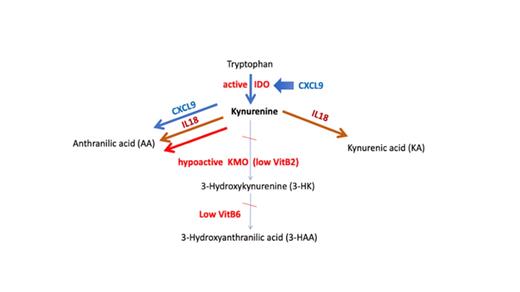Abstract
Background: Fibrosing chronic graft-versus-host disease (cGVHD) is a debilitating complication after allogeneic stem cell transplantation (allo-SCT), and its pathophysiology is poorly understood. Kynurenine and its metabolites were shown to associate with both, interferon-gamma (IFNg) activation and fibrosis. This study investigates the interplay between members of the IFNγ pathway and Kynurenin-derived metabolites in cGVHD.
Methods: Using a liquid chromatography tandem mass spectrometry approach on sera obtained on day+100 (n=430) and/or at onset of cGVHD symptoms (n=196) of our prospectively collected biobank after alloSCT, we measured concentrations of Kyn pathway metabolites (kynurenin (Kyn), anthranilic acid (AA), kynurenic acid (KA), 3-hydroxykynurenine (3-HK), and 3-hydroxy-anthranilic acid (3-HAA). We also measured C-X-C chemokine ligand 9 (CXCL9), interleukin (IL-)18, tryptophane (Trp) and indoleamine-2,3-dioxygenase (IDO) by ELISA.
Results: We observed increased CXCL9 and IDO levels, and increased activity of the Kynurenine pathway in both non-severe and severe cGVHD. Interestingly, severe fibrosing cGVHD differed from any other form of cGVHD in a significant pathway shift toward AA and KA. This resulted in a reduced 3-HAA/AA ratio. A score consisting of low 3-HAA/AA ratio and high KA serum levels at onset of mild cGVHD symptoms predicted risk specifically of severe fibrosing cGVHD. This altered pathway in severe fibrosing cGVHD correlated with reduced activity of the Vitamin-B2-dependent kynurenine monooxygenase, low vitamin B6, and increased interleukin-18. Our results are consistent with a triple-hit model for fibrosing cGVHD including low activity of kynurenine monooxygenase (KMO, Vitamin B2 and B6 dependent) in the context of high IL18 serum levels and CXCL9-induced IDO activation (Figure 1).
Conclusion: Chronic GVHD associates with an IFNg signature and increased activity of the Kynurenin pathway. KA and 3-HAA/AA defined the first molecular distinction between fibrosing and non-fibrosing cGVHD. The mechanism may involve Vitamin B2/B6 deficiency, and high CXCL9 and IL18. The Kyn metabolite signature is a candidate biomarker for severe fibrosing cGHVD and provides a rationale for translational trials on prophylactic Vitamin B2/B6 supplementation for cGVHD prevention.
Figure 1: Triple hit model of fibrosing cGVHD (Hypothesis):
Severe fibrosing cGVHD associates with a strong CXCL9-induced activation of IDO. The result of this activation is influenced by a reduced activity of kynurenine monooxygenase (KMO), either due to genetic polymorphisms or lack of Vitamin B2, and further aggravated by lack of Vitamin B6. The resulting metabolic deviation increases AA concentrations and reduces the 3-HAA/AA ratio. Finally, high IL-18 associates with increased serum KA. These three hits result in a metabolic situation with high KA and a low ratio 3-HAA/AA that predicts risk of fibrosing cGVHD.
Mueller-Tidow: Janssen Cilag: Consultancy, Research Funding; Pfizer: Consultancy, Research Funding; Bioline: Consultancy, Research Funding.


This feature is available to Subscribers Only
Sign In or Create an Account Close Modal